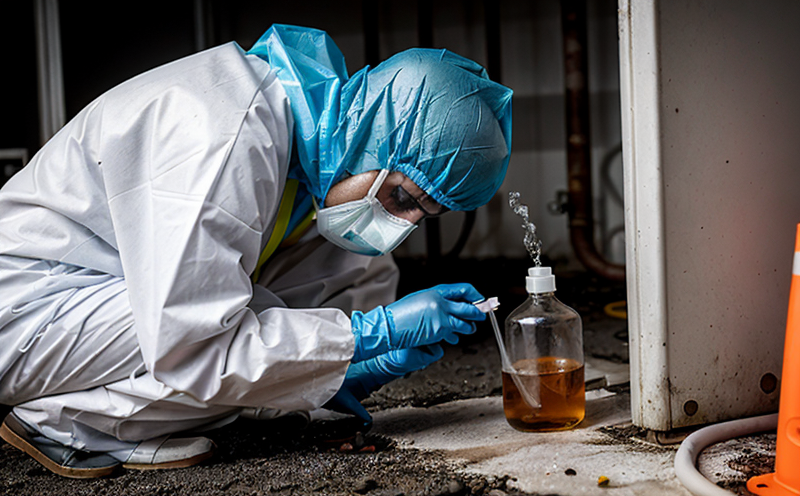ISO 52921 Contamination Analysis of Additively Manufactured Parts
The ISO 52921 standard provides a comprehensive framework for contamination analysis in additive manufacturing (AM) parts, ensuring that the products are fit for their intended purposes. This service is particularly crucial for industries where quality and reliability are paramount, such as aerospace, automotive, medical devices, and consumer electronics.
Contamination can arise from various sources during the AM process, including raw material impurities, residual solvents, metal dust, or other foreign materials introduced by handling equipment. These contaminants can significantly affect the mechanical properties of parts, leading to premature failure or reduced lifespan. The ISO 52921 standard helps manufacturers identify and mitigate such risks early in the production cycle.
The testing process involves several critical steps. First, the part is carefully prepared for analysis, which may include cleaning and surface treatment to minimize interference from external factors. Next, various analytical techniques are employed to detect and quantify contaminants. These methods can range from simple visual inspections using optical microscopes to more advanced spectroscopic analyses such as X-ray fluorescence (XRF) or energy-dispersive X-ray spectroscopy (EDS).
The standard specifies detailed procedures for sample preparation, method selection, and data interpretation. It also provides guidelines on how to report the findings in a manner that is both transparent and actionable. This ensures that stakeholders have a clear understanding of any issues identified during testing.
One of the key challenges in implementing ISO 52921 is ensuring consistency across different laboratories and test methods. The standard helps address this by providing standardized protocols, which are essential for generating reliable and reproducible results. This is particularly important given the diverse range of AM processes and materials used in modern manufacturing.
For industries like aerospace, where safety is non-negotiable, the ability to trace contamination sources back to specific batches or suppliers can be critical. ISO 52921 supports this by providing a robust framework for tracking contamination throughout the supply chain. This helps manufacturers maintain high standards of quality and reliability, even in complex supply networks.
In summary, adhering to the ISO 52921 standard is not just about compliance; it's about building trust with customers and ensuring that products meet or exceed industry expectations. By leveraging this service, businesses can enhance their reputation for delivering high-quality, reliable parts while reducing the risk of costly failures.
| Contaminant Type | Detection Method | Description |
|---|---|---|
| Residual Solvents | XRF Spectroscopy | Detects trace amounts of solvents in the part. |
| Metal Dust | SEM/EDS Analysis | Identifies metallic particles and their elemental composition. |
| Organic Residues | Infrared Spectroscopy (FTIR) | Analyzes molecular structures to identify organic contaminants. |
| Biocontaminants | Microbial Culture | Detects any biological contamination that could affect part integrity. |
Applied Standards
The ISO 52921 standard is one of several international standards aimed at ensuring the quality and reliability of additively manufactured parts. It complements other relevant standards such as ISO 52734, which focuses on dimensional accuracy in AM processes.
| Standard | Description | Scope |
|---|---|---|
| ISO 52921 | Contamination Analysis of Additively Manufactured Parts | Methodology for detecting and quantifying contaminants in AM parts. |
| ASTM F42 | Standard Practice for Evaluation, Testing, and Qualification of Additive Manufacturing Processes and Products | Guidelines for evaluating and qualifying AM processes and products. |
| EN 376 | Material Requirements for the Production of Metallic Powder for Use in Additive Manufacturing | Specifications for metallic powders used in AM. |
The ISO 52921 standard is particularly important because it provides a standardized approach to contamination analysis, which is critical for ensuring that parts meet the required quality standards. By following this standard, manufacturers can ensure that their products are free from harmful contaminants and are safe for use in demanding applications.
Quality and Reliability Assurance
The ISO 52921 contamination analysis service plays a vital role in the quality assurance process by providing objective data on potential issues with AM parts. This information can be used to make informed decisions about production processes, materials selection, and supplier management.
By identifying contaminants early in the manufacturing process, companies can take corrective actions before the part is finalized or shipped. This not only improves product quality but also reduces costs associated with rework or scrap. In industries where downtime is costly, this service becomes even more critical.
The standard also supports reliability assurance by helping to trace contamination back to its source. For example, if a batch of parts consistently shows high levels of metal dust, the manufacturer can investigate further and potentially recall the batch from distribution. This proactive approach helps prevent similar issues in future production runs.
In addition to direct quality improvements, ISO 52921 also contributes to broader business goals such as customer satisfaction and brand reputation. By demonstrating a commitment to high standards of quality and reliability, companies can build trust with their customers and stakeholders.
International Acceptance and Recognition
The ISO 52921 standard is widely recognized and accepted in the global AM industry. Its adoption by leading manufacturers and regulatory bodies underscores its importance in ensuring product quality and reliability.
Governments, standards organizations, and industry associations around the world have endorsed this standard, making it a key component of international best practices for AM parts. This broad recognition ensures that the results of ISO 52921-compliant testing are widely accepted across different regions and regulatory environments.
For businesses operating in multiple countries or seeking to comply with diverse regulations, adherence to this standard simplifies compliance efforts. It provides a single framework that can be applied globally, reducing complexity and costs associated with local variations in standards.





